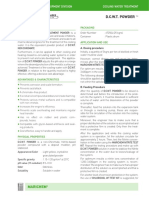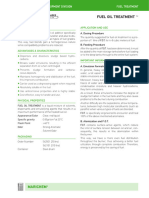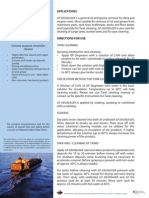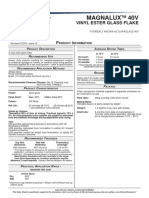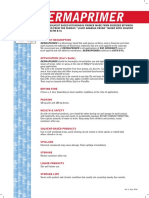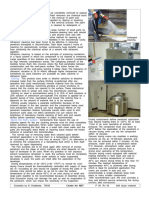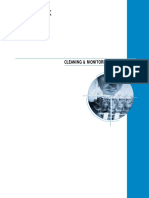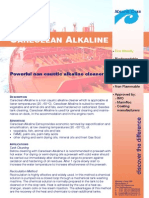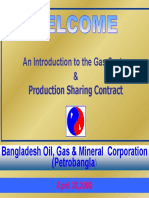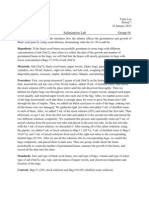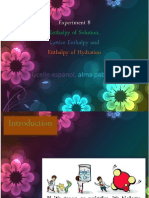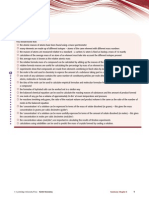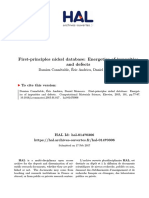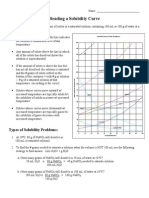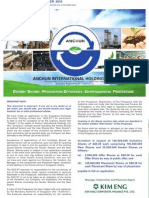Air Cooler Cleaner
Air Cooler Cleaner
Uploaded by
Sadat RahmanCopyright:
Available Formats
Air Cooler Cleaner
Air Cooler Cleaner
Uploaded by
Sadat RahmanOriginal Title
Copyright
Available Formats
Share this document
Did you find this document useful?
Is this content inappropriate?
Copyright:
Available Formats
Air Cooler Cleaner
Air Cooler Cleaner
Uploaded by
Sadat RahmanCopyright:
Available Formats
MARINE CHEMICALS & EQUIPMENT DIVISION GENERAL CLEANING & MAINTENANCE
AIR COOLER CLEANER TM
DESCRIPTION PACKAGING
AIR COOLER CLEANER is a concentrated liquid so- Order Number : 832501 (25 ltrs),
lution of aromatic hydrocarbons, powerful surfac- 832101 (210 ltrs)
tants, corrosion inhibitors and strong emulsifying
Container : Steel drum
agents designed to attack, penetrate and com-
pletely remove mineral oils, grease, soot and other
carbonaceous deposits from air coolers and tur- APPLICATION AND USE
bochargers in two & four stroke marine diesel en- A. Dosing Procedure
gines.
The quantity of AIR COOLER CLEANER to be used
is proportional to the degree of accumulation, the
ADVANTAGES AND CHARACTERISTICS available downtime and the surface area to be
• Efficiently removes oil, grease and carbon depos- cleaned. In any case, when decided, A.C.C. may
its from marine engines, air coolers, scavenging be used undiluted and in quantities feasible to ac-
systems and turbochargers. complish complete removal of the deposits, when
• Can be safely used on all metals and metal al- the accumulation is heavy. Whereas, in cases of
loys, as well as on components of an engine light deposition, A.C.C. may be used with diesel oil,
without causing any damage. the diluted solution should be appropriate enough
• Acts quickly and thoroughly. to accomplish the desired cleaning.
• Prevents the ignition of oil, sludge and soot ac- Using A.C.C. diluted with diesel oil or undiluted is
cumulation. beneficiary as the solution may be reused for fu-
• Non corrosive, non–toxic and non–volatile. ture oil removal on other engine parts. Note that
• Water–soluble and when dissolved forms a the above–mentioned is not feasible when the
white–milky emulsion. A.C.C. is diluted with water.
• No known effect on rubber and plastic compounds.
B. Cleaning Procedure
• May be combined with a specific range of other
products. The application of A.C.C. can be done by the circu-
• Cost effective, corrosion proof, easy to apply and lation, soaking and the injection method.
use. Circulation is the method used when dismantling
of the air cooler is not possible. In this cleaning
PHYSICAL PROPERTIES procedure the air cooler is connected to a buffer
tank with inflow and outflow piping, the A.C.C. is cir-
AIR COOLER CLEANER is an organic solvent–based
culated through, during a period of 4–6 hours by
liquid solution consisting of surface–active agents,
use of a pump. The solution may be heated at a
a blend of aromatic hydrocarbons and powerful
temperature up to 30°C so that we ease the clean-
emulsifying agents.
ing procedure and accomplish better results. This
Appearance / Color : Clear, colorless liquid will significantly reduce the cleaning time, whilst
Specific gravity : 0.85 gr/cm3 at 15°C improving the cleaning effect.
Solubility : Appreciable Soaking is the method to be used on dismantled
Flash point : >40°C air coolers; they should be immersed in a bath
Odor : Aromatic Solvent Odor filled with undiluted A.C.C. In the meantime, the
cleaning process can be started by agitating the
solution, while heating should be applied at ap-
proximately 30°C. Leave to soak for approximately
2 hours, afterwards, remove from bath, rinse with
large amounts of warm water under pressure, then
blow–dry with air. Note that the immersion period
and heating temperature are dependent on the se-
verity of contamination.
MARICHEM® Section C, Part 3
GENERAL CLEANING & MAINTENANCE MARINE CHEMICALS & EQUIPMENT DIVISION
Injection is the method, which should be used
for the following cases, those dealing with static,
those when dismantling is not possible, and those
when the air cooler uses a high–pressure machine.
In this procedure, the A.C.C. is directly injected into
the air cooler unit, which is then left to soak for
as long as is needed, in order to keep the depos-
its soft. Afterwards, rinse thoroughly with plenty of
fresh warm water using a high pressure supply and
blow it dry with air.
Note that if necessary, the cleaning procedure
may be repeated depending on the degree of de-
posit accumulation.
This cleaning method is only recommended if ap-
proved by engine manufacturers.
SAFETY AND HANDLING
HANDLING Handle with care. Store in a dry, cool and well ventilated environment.
SAFETY IMMEDIATE ACTIONS
Avoid Eye contact. Otherwise, flush with plenty of water for a few minutes.
Eye Contact
Seek medical attention.
Avoid Skin contact. Otherwise, wash contaminated area thoroughly with water.
Skin Contact
Seek medical attention.
Do not breathe gas/vapors. Otherwise, seek fresh air source at once. Seek medical attention.
Inhalation In case of insufficient ventilation, wear suitable respiratory equipment.
Avoid ingestion. Otherwise, consume a considerable quantity of water.
If Swallowed
Do not induce vomiting. Seek medical attention.
GENERAL Avoid spillage, splashing and mishandling. Precautionary measures for body protection are strongly
INSTRUCTIONS recommended before use.
Read the Material Safety Data Sheet before using this product.
For detailed information on safety and health, please refer to Material Safety Data Sheet and/or Product Label.
MARICHEM MARIGASES Worldwide Services or any subsidiary or associated companies warranties of merchantability and competence, if any, along
with any expressed warranties concerning this merchandise, shall not be actionable or pertinent or effective if the good is used contrarily or differently
to the directions herein and in no other way due to impending hazards from inappropriate use of the good explained herein. Merchandise might vary
insubstantially depending on country of origin. The information provided concerning merchandise is exclusively presented to the customer.
Section C, Part 3
You might also like
- Concentration of Solutions DLPDocument3 pagesConcentration of Solutions DLPLouise Meara Severo70% (10)
- How Industrial Businesses Can Reduce Production Costs With Reverse Osmosis: Industrial Reverse OsmosisFrom EverandHow Industrial Businesses Can Reduce Production Costs With Reverse Osmosis: Industrial Reverse OsmosisRating: 5 out of 5 stars5/5 (1)
- Water LoseDocument29 pagesWater LoseJAKLIN EMPOLNo ratings yet
- Absorption & StrippingDocument875 pagesAbsorption & StrippingM Manas Manohar86% (56)
- Marichem C R LTDocument2 pagesMarichem C R LTVal VelasquezNo ratings yet
- Air Cooler Cleaner L.T.Document2 pagesAir Cooler Cleaner L.T.Adrian GavrilaNo ratings yet
- Soot CleanerDocument2 pagesSoot CleanerNeeraj KumarNo ratings yet
- MSDS - Alcaclean HDDocument2 pagesMSDS - Alcaclean HDRustan Paolo ReyesNo ratings yet
- Marichem PCSDocument2 pagesMarichem PCSEarl John V. PagayonNo ratings yet
- Oil & Grease Remover 1Document2 pagesOil & Grease Remover 1Thinh NguyenNo ratings yet
- Pickling LiquidDocument2 pagesPickling LiquidAhmedAl-agwedNo ratings yet
- Alcaclean HD 1Document2 pagesAlcaclean HD 1leventasarNo ratings yet
- Alcaclean XFDocument2 pagesAlcaclean XFddrak1964No ratings yet
- Descaler Liquid 555Document2 pagesDescaler Liquid 555Ιωαννης 26No ratings yet
- DCWT PowderDocument2 pagesDCWT PowderNeeraj KumarNo ratings yet
- Fuel Oil TreatmentDocument2 pagesFuel Oil Treatmentjagdevjamadar1No ratings yet
- Cooling Tower and Chiller CleaningDocument38 pagesCooling Tower and Chiller CleaningQOBIT100% (3)
- Vecom Marine Air Cooler CleanerDocument5 pagesVecom Marine Air Cooler Cleanerlin224995No ratings yet
- MSDS - Blue Energy 3000 Sakoon OilDocument4 pagesMSDS - Blue Energy 3000 Sakoon OilMuhammad ZahidNo ratings yet
- Boiler Sludge Conditioner PDFDocument2 pagesBoiler Sludge Conditioner PDFShashi Naganur100% (1)
- 08) Coolers and CondensersDocument16 pages08) Coolers and CondensersShafei ZawahryNo ratings yet
- HEMPADUR MULTI-STRENGTH 35530 BlackDocument2 pagesHEMPADUR MULTI-STRENGTH 35530 BlackRuby Faith EspinosaNo ratings yet
- Chemical Cleaning and FoulingDocument4 pagesChemical Cleaning and FoulingoswaldoNo ratings yet
- Mariclean DG 25Document2 pagesMariclean DG 25arnoldNo ratings yet
- GP Degreaser: Vecom MarineDocument2 pagesGP Degreaser: Vecom MarineHernan GirautNo ratings yet
- Closed Loop Aqueous WashingDocument10 pagesClosed Loop Aqueous WashingLee W JohnNo ratings yet
- 17 ARCEL - C 03 (Membrane Cleaner for Inorganic)Document5 pages17 ARCEL - C 03 (Membrane Cleaner for Inorganic)Kemas RamaNo ratings yet
- Product Data: Hempadur Multi-Strength 35530Document2 pagesProduct Data: Hempadur Multi-Strength 35530Vijayaraj KumarNo ratings yet
- TRB 1120 32Document3 pagesTRB 1120 32nickchoNo ratings yet
- DES-CASE - Breather White Paper - SmallDocument14 pagesDES-CASE - Breather White Paper - SmallGonzalo Enrique Caceres GarridoNo ratings yet
- Falchem Spec SUPER SOLDocument2 pagesFalchem Spec SUPER SOLUdana HettiarachchiNo ratings yet
- Falchem Spec SAF ACID - POWDERDocument3 pagesFalchem Spec SAF ACID - POWDERArjun NNo ratings yet
- B.W.T. New Formula: Description Application and UseDocument2 pagesB.W.T. New Formula: Description Application and UseNang D. VuNo ratings yet
- Pds Careclean Degreser GPDocument2 pagesPds Careclean Degreser GPAntzNo ratings yet
- alkaklDocument5 pagesalkaklmarosaraNo ratings yet
- GP Degreaser: Vecom MarineDocument2 pagesGP Degreaser: Vecom MarinejaimeNo ratings yet
- Practical Considerations For The Design of Adsorbent BedsDocument10 pagesPractical Considerations For The Design of Adsorbent BedsMariam AsgharNo ratings yet
- Cargo Cleaning LeafletDocument4 pagesCargo Cleaning LeafletRyslanNo ratings yet
- Repsol Carrera 5W50: DescriptionDocument2 pagesRepsol Carrera 5W50: DescriptionGiga KekaNo ratings yet
- Cleaning AC Coils ArticleDocument5 pagesCleaning AC Coils ArticleTauseefAhmadNo ratings yet
- Protective & Marine Coatings: Magnalux 40VDocument2 pagesProtective & Marine Coatings: Magnalux 40VMd Usama100% (1)
- Carbon RemoverDocument2 pagesCarbon RemoverrpichoNo ratings yet
- Hempadur Primer 15300Document3 pagesHempadur Primer 15300vitharvanNo ratings yet
- RMC Online Washing System Industrial Gas TurbineDocument3 pagesRMC Online Washing System Industrial Gas TurbinepayamzarNo ratings yet
- Dermaprimer: Product DescriptionDocument2 pagesDermaprimer: Product DescriptionSaud NawabNo ratings yet
- j6) Autocareenamel 3087Document2 pagesj6) Autocareenamel 3087vinodNo ratings yet
- 15553Document2 pages15553danish100% (1)
- L4 Solvent ScouringDocument5 pagesL4 Solvent ScouringAbdul kaderNo ratings yet
- k3) Luxatherm5600 7954Document2 pagesk3) Luxatherm5600 7954Syed FaridNo ratings yet
- PR Cleaner Degreaser PDS 122316 CDocument3 pagesPR Cleaner Degreaser PDS 122316 CMidyanNo ratings yet
- Surface 2Document1 pageSurface 2kattabommanNo ratings yet
- Chinese Cleaning and Monitoring PDFDocument6 pagesChinese Cleaning and Monitoring PDFAisyah UmarNo ratings yet
- PDS en-GB 45751Document2 pagesPDS en-GB 45751Anuar SalehNo ratings yet
- Epilux 155 SFDocument2 pagesEpilux 155 SFMohamed NasifNo ratings yet
- PDS - Berger Weathercoat 345 - StdRev 9Document2 pagesPDS - Berger Weathercoat 345 - StdRev 9Aru VijayNo ratings yet
- CLEAN-BREAK enDocument2 pagesCLEAN-BREAK enözgür ünlüNo ratings yet
- Uses of Degreasing: Cold CleaningDocument3 pagesUses of Degreasing: Cold CleaningukalNo ratings yet
- 001 - Hold Cleaning Method and EquipmentDocument7 pages001 - Hold Cleaning Method and EquipmentALP ASLANNo ratings yet
- Microsoft Word - L3 - Epilux82Document2 pagesMicrosoft Word - L3 - Epilux82vitharvanNo ratings yet
- Pds Careclean Alkaline - TCDocument3 pagesPds Careclean Alkaline - TCSava MarianNo ratings yet
- Luxaprime1501 Etch PrimerDocument2 pagesLuxaprime1501 Etch PrimerGurdeep Sungh AroraNo ratings yet
- BMC - H60 Humidifier ESTERILIZACION INGLESDocument4 pagesBMC - H60 Humidifier ESTERILIZACION INGLESAna Teresa Manjarres MonteroNo ratings yet
- How Reverse Osmosis Works: A Look at Industrial ROFrom EverandHow Reverse Osmosis Works: A Look at Industrial RORating: 2.5 out of 5 stars2.5/5 (2)
- Convocation PaymentDocument1 pageConvocation PaymentSadat RahmanNo ratings yet
- Twin Check: Electronic Water-in-Oil / BN TestDocument1 pageTwin Check: Electronic Water-in-Oil / BN TestSadat RahmanNo ratings yet
- Basic Water ChemistryDocument21 pagesBasic Water ChemistrySadat RahmanNo ratings yet
- Petrobangla Production Sharing Contract PresentationDocument94 pagesPetrobangla Production Sharing Contract PresentationSadat RahmanNo ratings yet
- CH 4. Some Basic Concepts of Chemistry (Chem +1)Document43 pagesCH 4. Some Basic Concepts of Chemistry (Chem +1)Dipin Preet SinghNo ratings yet
- Group 5 - NaCl Purification and Synthesis of KNO3Document29 pagesGroup 5 - NaCl Purification and Synthesis of KNO3Wifqul LailyNo ratings yet
- Zinc Chloride Determination ProcedureDocument13 pagesZinc Chloride Determination ProcedureSreedhar Patnaik.MNo ratings yet
- Apes Salinization LabDocument4 pagesApes Salinization LabYujin LeeNo ratings yet
- Introduction To Clinical PathologyDocument20 pagesIntroduction To Clinical PathologySwagath NNo ratings yet
- Unit Operations and Unit ProcessesDocument3 pagesUnit Operations and Unit ProcesseslaurenNo ratings yet
- COA MetforminDocument12 pagesCOA MetforminPrasad Babu A100% (1)
- Chemistry SatDocument17 pagesChemistry SatAriana GameroNo ratings yet
- Alum CrystalsDocument5 pagesAlum CrystalsAJ BragadoNo ratings yet
- Diffusin How To Calculate Diffusion Calculation in Excel Sheet PDFDocument6 pagesDiffusin How To Calculate Diffusion Calculation in Excel Sheet PDFsagar kishor savaleNo ratings yet
- Synthesis of Thiazolidine-4-One For Their Anthelmintic ActivityDocument4 pagesSynthesis of Thiazolidine-4-One For Their Anthelmintic Activitylox agencyNo ratings yet
- Chem 156.1 Experiment 8 (Solution, Lattice, Hydration)Document54 pagesChem 156.1 Experiment 8 (Solution, Lattice, Hydration)Alma PabilaneNo ratings yet
- Educational Brief: A NASA Recipe For Protein CrystallographyDocument18 pagesEducational Brief: A NASA Recipe For Protein CrystallographyingrossNo ratings yet
- AiisDocument17 pagesAiisayushNo ratings yet
- Eoy Review Student Questions KeyDocument4 pagesEoy Review Student Questions Keyapi-234918521No ratings yet
- Factors Affecting SolubilityDocument3 pagesFactors Affecting SolubilityJason Raquin RoqueNo ratings yet
- Issue No 16 Solid Solution Hardening StrengthDocument2 pagesIssue No 16 Solid Solution Hardening StrengthIslamNo ratings yet
- © Cambridge University Press IGCSE Chemistry: Summary: Chapter 6Document1 page© Cambridge University Press IGCSE Chemistry: Summary: Chapter 6Princess KimNo ratings yet
- Process Advancement in Chemistry and Chemical Engineering Research (2015) PDFDocument378 pagesProcess Advancement in Chemistry and Chemical Engineering Research (2015) PDFnico123456789No ratings yet
- First-Principles Nickel Database: Energetics of Impurities and DefectsDocument13 pagesFirst-Principles Nickel Database: Energetics of Impurities and DefectsSayyadh Rahamath BabaNo ratings yet
- Solubility CurveDocument2 pagesSolubility CurveDanni SulaimanNo ratings yet
- Cathinone SynthDocument6 pagesCathinone Synthd4rk30% (1)
- Registration Prospectus (Clean) (131010)Document355 pagesRegistration Prospectus (Clean) (131010)ckyeak100% (1)
- 71 Sterility Test Usp41Document8 pages71 Sterility Test Usp41hh_543No ratings yet
- Preparation 1: Syrup: Types of Syrup DDS (Laboratory)Document5 pagesPreparation 1: Syrup: Types of Syrup DDS (Laboratory)Kate MendozaNo ratings yet
- Experiment 1Document7 pagesExperiment 1Mhi Ismail0% (1)
- Test Method For Papaya ExtractDocument2 pagesTest Method For Papaya Extractfujoshi meNo ratings yet














